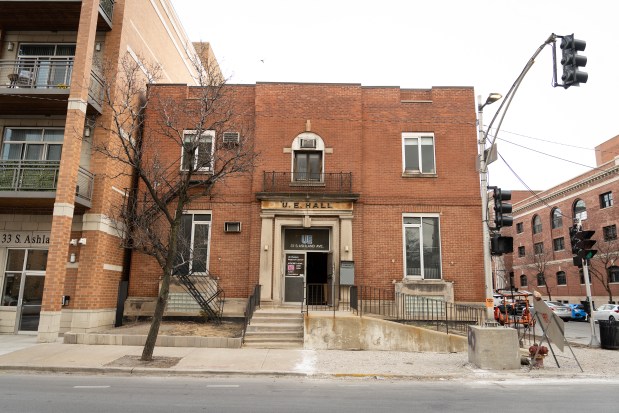The United Electrical Workers union is teaming up with an art group to save a historic mural — considered one of the oldest public art pieces in the Chicago area — inside its Near West Side meeting hall, a space that will soon be developed into apartments.
The sprawling mural, titled “Solidarity,” spans the building’s two lobbies and central staircase, narrating the history of industrial unionism. A team of artists painted the vibrant work in the style of Diego Rivera between 1973 and 1974.
“To be surrounded by the mural is just tremendously inspiring and empowering,” said Carl Rosen, the union’s general president. The organization, also known as the United Electrical, Radio & Machine Workers of America, represents tens of thousands of workers nationwide. “It’s so important that it’s being preserved.”
The Chicago Public Art Group worked with UE to raise over $200,000 for the massive preservation project. Conservators will painstakingly remove the delicate mural from its plaster walls.
“It’s really important for us to safeguard and protect these old works of art that preserve the history and culture of the union labor movement,” said Chantal Healey, executive director of the Chicago Public Art Group.
The mural depicts striking scenes of workers’ struggles and triumphs in the 20th century. Lead artists John Pitman Weber and the late Jose Guerrero petitioned the union to paint the hall, eager to break into the budding community mural movement.
“I’m very pleased,” said Weber, now 81. “It’s a great honor that sections of it are going to be saved.”
Rosen said the UE made the difficult decision to sell the union hall two years ago. The two-story brick building on South Ashland Avenue was originally built for the West End Woman’s Club in 1904. The club regularly met philanthropic and educational work, advocating for social reform, according to Chicago Public Library records.
In 1948, the western region of UE moved in, continuing the building’s legacy as a space for social advocacy. The building has been featured in the Chicago Architecture Center’s annual Open House Chicago tour.
The union hall was once essential to UE’s operations. Local union members would gather to vote and hold meetings. Though it primarily served as the western region headquarters, it also housed national staff based in Chicago. Later, other unions and labor-related nonprofits would rent office space on the lower floors.
“I grew up in this building, in many ways,” said Rosen, who has been involved with the union since 1984. “It’s hard to say goodbye.”
Since the COVID-19 pandemic, many of UE’s operations have been conducted remotely. Gentrification has also transformed the neighborhood, making parking impractical for employees. The sale to the apartment developer was finalized Tuesday.
“We were able to get a fair sale price for the building,” Rosen said. “We can invest that money back in organizing unorganized workers, which is what we’ve been doing very successfully for years.”
Last year, UE contacted the Chicago Public Art Group, which Weber co-founded, to find a way to salvage the mural. After launching the fundraising campaign, the project began Feb. 16.
While painting the mural, both artists juggled full-time jobs – Weber was a teacher, and Guerrero worked in a factory. It took over a year to complete. The pair spent months studying the inner workings of the union, hoping to capture the dogged spirit of the organization.
For Weber, the most striking piece of the mural depicts a suit-clad industrialist clutching a safe, sounded by symbols of oppression and violence – the military, guns and even a member of the Ku Klux Klan. A group of workers encircles them with fists in the air.

“The enemy is an idea, it’s a corporate entity and a societal role,” Weber said. “You’re fighting a part of the system, and we tried to represent that. We did our best.”
The artists were only paid $2,000 to cover the cost of paint, brushes and scaffolding.
“It’s almost a mind-blowing contrast between how much saving the section is costing, and the willingness to do that, and how it got done in the first place,” Weber said. “It’s very touching.”
Donations are still needed to preserve the work, the organizations said. The $200,000 raised is only enough to remove about 75% of the mural. Even saving small sections is an extremely complicated process, according to Healey.
Conservators must carefully cut out the backings of the walls before carving around the images. Some of the plaster pieces, which weigh hundreds of pounds, have to be hoisted out of the building.
“If we had been able to look into the future, we might have wanted to do it on panels,” Weber said with a laugh.
Some sections that were already removed were painted on load-bearing walls, so workers had to construct makeshift supports to ensure the integrity of the building.
“That was much more complicated, and we had to put another bearing component to make it structurally solid,” Healey said.
The fragmented pieces will be displayed in the office of the Chicago Teachers Union, as well as a UE building in Erie, Pennsylvania. UE plans to rent office space from the CTU, allowing the mural to remain visible to members.
It’s a comforting thought for Rosen.
“What’s hardest is leaving the mural,” Rosen said. “To think about, all of the other folks who have struggled to build the union, and make a better life for working people, those ideas would be with you as you walked in to start your workday.”



